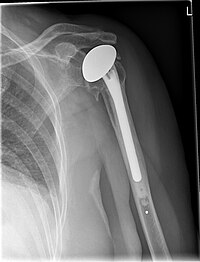
Photo from wikipedia
Purpose: Hypotensive anesthesia is crucial during arthroscopic shoulder surgery to reduce bleeding and allow for clear visibility. The aim of this study was to compare the clinical efficacy of continuous… Click to show full abstract
Purpose: Hypotensive anesthesia is crucial during arthroscopic shoulder surgery to reduce bleeding and allow for clear visibility. The aim of this study was to compare the clinical efficacy of continuous infusion of remifentanil, nicardipine, and remifentanil plus nicardipine to control hypotensive anesthesia in arthroscopic shoulder surgery. Methods: For this study, we enrolled 45 consecutive patients who were scheduled to have arthroscopic rotator cuff repair surgery and randomly allocated them into remifentanil (group R, n = 15), nicardipine (group N, n = 15), and remifentanil plus nicardipine (group RN, n = 15) groups. During the surgeries, these drugs were administered with continuous infusion. We analyzed the mean arterial pressure (MAP) and heart rate during surgery, stay time in the recovery room, visual analogue scale (VAS) scores, use of antiemetics in the recovery room, and postoperative blood urea nitrogen and creatinine changes. Results: The VAS score in the recovery room was higher for group R (mean 5.6, SD 1.4) than for groups N (mean 3.9, SD 0.9) and RN (mean 4.0, SD 1.1; p = 0.000). There were no statistical differences regarding other clinical variables among the three groups (all p > 0.05) except for MAP at 120 min of surgery between groups N and RN (N: 84.67 (SD 10.7) mmHg, RN: 65.4 (SD 9.2) mmHg, p = 0.027). Conclusion: The continuous infusion of remifentanil plus nicardipine appeared to be advantageous for maintaining hypotensive anesthesia until 120 min of arthroscopic shoulder surgery without rebound pain in a postanesthesia care unit.
Journal Title: Journal of Orthopaedic Surgery
Year Published: 2017
Link to full text (if available)
Share on Social Media: Sign Up to like & get
recommendations!